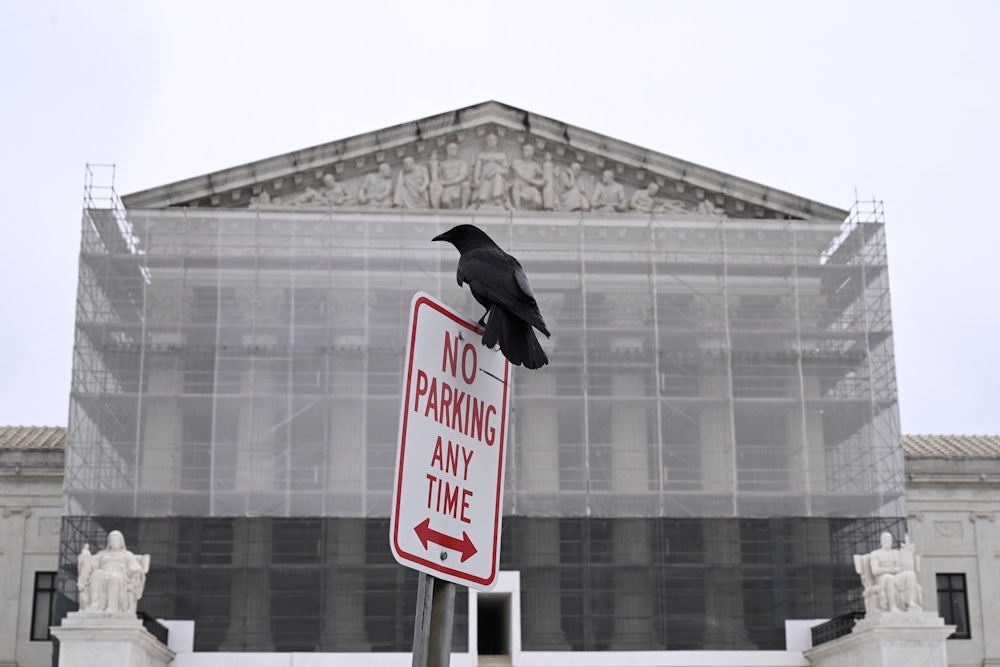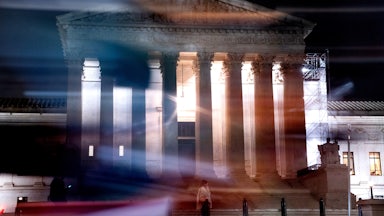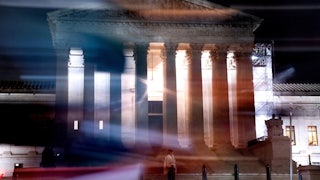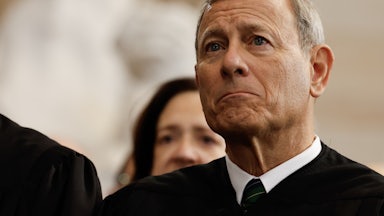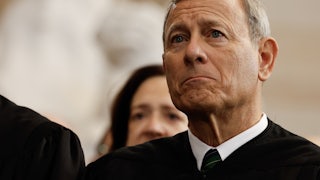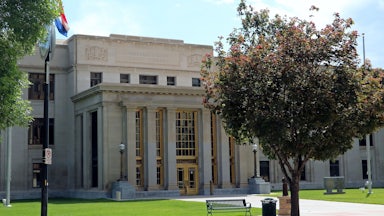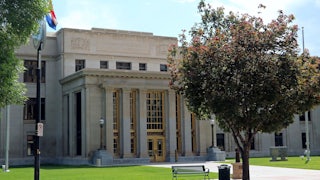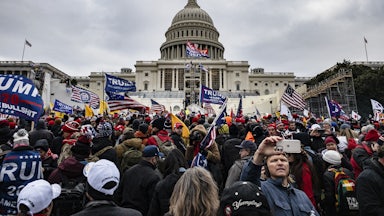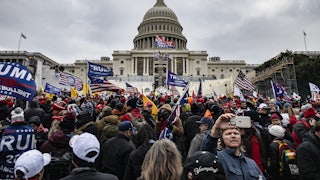The Supreme Court’s conservatives spent most of last term accepting, then granting, an unprecedented slew of heretofore-rare Justice Department “emergency applications” from the court’s so-called “shadow docket,” most in the service of staying lower court bars against myriad Trump administration actions bloating presidential powers. Thereby, the justices enabled Trump to continue breaching preexisting boundaries without having to decide on the merits whether his power grabs actually violate relevant law. In most cases, the justices issued these often highly consequential edicts with no explanation to help parties, lower courts, other governmental branches, or the public get an inkling of what their final decision might be, or what analytical approach they will deploy.
But in recent weeks, Trump’s gluttony for norm-breaking has reached heights that preclude the justices from continuing to kick these cans down the road. In the term that begins next month, they will have to stop dithering and decide issues that could make or break his presidency. On September 9, the court agreed to review two lower court rulings that held that Trump’s huge new tariffs lack any statutory authorization and would, one appellate court held, usurp “the power of the purse (including the power to tax) [which under the Constitution] belongs to Congress.” This past Monday, September 15, an appellate panel upheld Federal Reserve Governor Lisa Cook’s challenge to Trump’s attempt to fire her without statutorily prescribed “cause.” A day later, the White House announced its intent to appeal that defeat to the Supreme Court.
A number of prominent liberal court-watchers, such as law professors Lawrence Tribe and Leah Litman, pundit and author Ian Milhiser, and, at times, Supreme Court Justices Sonia Sotomayor, Elena Kagan, and Ketanji Brown-Jackson, have ascribed the conservative majority’s receptivity to Trump shadow docket requests to rank partisanship. Much evidence lends credibility to that charge. As of this writing, the Trump Justice Department has filed 20 emergency applications with the court in its brief tenure, compared with a 16-year total of eight such applications from the George W. Bush and Barack Obama administrations, or one every other year.
This year, the court granted 18 of Trump’s requests to stay adverse lower court orders, usually over fierce dissents from liberal justices. Georgetown law professor Stephen Vladeck spotlighted the “rather obvious contrast—where serious standing objections were not enough to justify emergency relief when it was the Biden administration looking to put its student loan debt relief back into effect, but where ... weaker standing objections were enough to justify allowing [President Trump] to effectively strangle a critical federal agency.” (Emphasis in the original.) Trump had fired 50 percent of the Department of Education’s workforce overnight. By letting this decapitation stand for as long as Trump manages to slow-roll litigation challenges, the conservative justices may well have enabled him to render his starkly unlawful objective—unilaterally terminating a congressionally enacted department and multiple duly enacted programs—a fait accompli.
But writing off the justices’ recidivist misbehavior solely to partisanship fails to account for aspects of the record in which one or more of the Republican presidential appointees, as well as numerous lower court judges appointed by Republican presidents, including by Trump, spoke out and ruled against critical elements of his imperious modus operandi.
During and prior to this second Trump administration, Republican-appointed judges and justices rejected his efforts to overturn the 2020 election over 60 times. In April and May of this year the court enjoined, pending a final decision, the administration’s effort to summarily deport undocumented, alleged Venezuelan gang members; the Justice Department claimed as authority the Alien Enemies Act, a law enacted in 1798 and gathering dust ever since. The court sidelined the administration’s (lame) statutory argument with the Constitution’s Fifth Amendment guarantee that government cannot deprive any person of liberty without due process of law. Roberts’s opinion for the court admonished that, for deportation targets, the government must provide “sufficient time and information to reasonably be able to contact counsel, file a petition, and pursue appropriate relief.” He chastised DOJ for flimflamming the lower courts and the Supreme Court with falsified factual representations, and reached outside the record to assail administration officials’ threats and actions to evade or defy court orders.
In 2019, Roberts wrote the court’s opinion quashing Trump’s scheme to include on the 2020 census questionnaire a question on individuals’ citizenship, intended to deter Hispanic citizens from voting; Roberts’s blistering rebuke called out Commerce Secretary Wilbur Ross, acting at the behest of Trump, for lying to the public and the courts, including the Supreme Court, “from the time he entered office,” acting in “bad faith,” spinning a story that appears “contrived,” “incongruent” with what at least two departments, Commerce and Justice, with White House complicity, actually did, a “disconnect between the decision made and the explanation given.”
On earlier occasions, in 2012 and 2015, Roberts provoked venomous, lasting fury from numerous Republican politicians, advocates, and voters when he twice upheld the Affordable Care Act against challenges that would, if granted, have nailed to the wall the Republican Party’s top policy priority of extinguishing Democrats’ premier twenty-first-century accomplishment.
The court’s 2022–23 term startled observers with unexpected rebuffs to propositions long brandished by the legal right—including the chief justice. In that term, Roberts, after decades of fuming against the 1965 Voting Rights Act, lauded the VRA for “creating stringent new remedies attempting to forever banish the blight of racial discrimination in voting … the most successful civil rights statute in the history of the nation.” In another welcome surprise, he put the kibosh on the notoriously antidemocratic “independent state legislature theory,” or ISLT, which would empower state legislatures to override their state’s voters’ choices in elections for federal office. In his opinion, Roberts reaffirmed a 5–4 decision from 2015 that had rejected ISLT, to which he had filed a vehement dissent.
Naturally, Justices Samuel Alito and Clarence Thomas have dissented from most of these tacks to the center or left. But to conflate their admittedly partisan, inflexibly hard-right regimen with the other four conservative justices’ does not fit the facts. As Professor Vladeck has elaborated, this sort of it’s-all-partisan-politics “doomerism” is, “as a factual matter, simply silly.” Even as regards the Trump administration, Vladeck details, “law and legal constraints are having a major influence ... consider[ing] the (many) cases in which the Trump administration is losing in the lower courts, not appealing, or not seeking emergency relief while it appeals (so the lower court decisions are going into effect, and complying with adverse rulings).”
To ignore those four justices’ periodic turnabouts, and the Trump DOJ’s attentiveness to signals of the limits of their deference, is not merely inaccurate. Far more important, declining to acknowledge the justices’ swerves, and suss out where and why they are likely to draw lines, amounts to cursing the darkness instead of lighting a candle. Lighting that candle requires building a fact-based foundation for pursuing what all liberals’ overriding goal must now be: turning back Trumpism’s existential threat to the Constitution.
Any plan for achieving that goal must feature workable strategies for preserving the independence that the federal courts, especially the Supreme Court, require to execute their core mission of upholding the rule of law. Liberals of all stripes should be laser-focused on framing legal and political advocacy to reinforce the justices’ recognition of their institutional imperative to prioritize its defense, their strategic acuity, and confidence that they and their allies can prevail. As of now, the conservative justices are not there. Liberals need to mobilize political, media, and public support sufficient to reverse the Supreme Court’s apparent drift toward political irrelevance.
Perceptions of that drift have generated a second explanation: not partisan so much as calculated. This view casts the court’s ducking and finessing as delaying actions to postpone an interbranch collision, which the justices fear they could lose, with catastrophic implications for the federal judiciary’s clout and stature, especially that of their own court. Albeit speculative, this take is hardly implausible.
Indeed, at least in part, risk avoidance must color the thinking of Chief Justice Roberts and the three Trump appointees who, ironically, are Trump’s least reliable conservative allies. On September 13, Harvard law professor and senior Obama official Cass Sunstein asserted, citing unnamed but “authoritative” sources, that the justices are “aware that the president might say, ‘we’re not going to follow what [the Supreme Court] orders.’” Senior administration officials, including the vice president and the director of the office of management and budget, have in fact threatened just that.
But such a fear-of-confrontation strategy is hard to square with how poorly much of the court’s pusillanimous maneuvering is working, or can work. To build the public and political support requisite to gain the upper hand in this political struggle, the court cannot avoid and must lead; the justices’ priority should be to shore up perceptions of its own legitimacy and fidelity to the rule of law.
But that’s not happening. As George Washington University law professor and veteran constitutional litigator Alan Morrison put it: “The Trump administration’s string of procedural victories poses a problem for the perceived legitimacy and neutrality of the Supreme Court and encourages the president to continue pressing his advantage until the justices clarify whether his actions are lawful.” More generally, the justices do themselves no favor to encourage their onetime brethren on the political right to see them as gettable pawns of this newly radicalized Republican Party’s drive for unconstrained power.
Players as seasoned as, say, John Roberts or Brett Kavanaugh must recognize these perils of their current seeming drift. I would suggest a third explanation: not just partisanship or (misguided) political strategy. These justices could be paralyzed by a self-inflicted jurisprudential/ideological dilemma: To quash Trump’s campaign to subvert the Constitution, and incinerate the court’s institutional primacy as its oracle, the justices must somehow extricate themselves from doctrinal quagmires that they themselves have dug.
Indeed, Trump’s Justice Department litigators have brandished some of these jurisprudential confections to justify the administration’s lawless machinations. Something has to give: The justices must either drop ploys they have embraced, largely to augment their own power, or shirk their core mission and undermine their raison d’etre as a coequal federal branch. So far, they have been unwilling to face up to that choice.
Consider how doctrinal inventions embraced by the Roberts court stand athwart its path to stand up to Trump’s drive for unchecked control of the Federal Reserve. As I and others have written, compromising the Fed’s independence would saddle the court with impossible-to-hide responsibility for “crashing” the national and global economies. But avoiding such a catastrophe would run head-on into a constitutional “unitary executive theory,” which, though lacking any textual or historical (that is to say “originalist”) foundation, has progressively been ratcheted up in Roberts court opinions.
In April of this year, I wrote that the court might well back off following the theory to its logical end point, and not free presidents to summarily fire, without cause, heads of multimember heretofore independent agencies exemplified by the Fed. Even conservative financial legal experts saw no principled basis, “no Court-approved avenue” to distinguish the Fed from other multimember independent agencies like those involved in a then-pending case, the National Labor Relations Board, or NLRB, and the Merit Systems Protection Board, or MSPB.
However, to the surprise of most court-watchers, all six
conservative justices in a May 22 shadow docket ruling opted to
try to have their cake and eat it too. In a gratuitous aside, they signaled
that, when the case returns for a final ruling on the merits, they would rule
that the unitary executive theory is good constitutional law and invalidates
the “for-cause removal” restrictions that Congress for well over a century has
placed on presidents’ ability to fire myriad sensitive multimember
commissioners or board members.
However, they foreshadowed that they would make this seismic constitutional
rewrite inapplicable to one such agency, the Fed. For this ad hoc
carve-out, they did not so much as purport to offer a legally coherent basis.
On the contrary, they contended in effect that no such principled legal
distinction was necessary. They put forward a single sentence: “The Federal
Reserve is a uniquely structured, quasi-private entity that follows in the
distinct historical tradition of the First and Second Banks of the United States.”
The problems with this ipse dixit assertion are as numerous as they are
blatant—weasel-worded, factually inaccurate, and in any event lacking legally
probative force.
For Trump and his strategists, unitary executive theorizing is not some abstract ideological plaything. It has always been a gambit aimed precisely at enabling Trump to gain full control of the Fed—for all the reasons that the Fed’s 1913 congressional creators and judicial interpreters since then have buttressed the walls around its independence. So the Trump strategists called the court’s bluff, and in so doing obtained a bullet that the justices cannot dodge. Rather than challenge the justices’ law-free assertion that for-cause removal remains uniquely applicable to the Fed, they have come up with a purported interpretation of the statutory term “for cause,” that will, if a majority of the justices can be bullied into accepting it, render the statutory guarantee of independence meaningless in practice.
As conservative financial legal expert Peter Wallison explained in National Review, the Trump Justice Department’s claim that the president may remove a Fed governor on the basis of a mere allegation of a personal error—“solely the word of a person likely eager to win praise (or more) from President Trump”—is functionally indistinguishable from terminable-at-will status. To preserve the Fed as a bulwark of national and global financial stability, the court must rule that the administration’s gutting “interpretation” doesn’t match the reasons for, hence the legal requirements of, the “historical tradition” it credited with safeguarding the Fed’s independence.
But to thus rule unitary executive theory inapplicable to the Fed, the court will lay bare the incongruity of stripping independence from other identically structured agencies with sensitive missions, such as, for example, the Federal Communications Commission, or the aforementioned NLRB and MSPB. No ingenious rationale will dissuade anyone from seeing the court’s selective application of the unitary executive scam to empower itself to pick winners and play political favorites, rather than apply standards recognizable as law.
The case that Trump may consider the single most provocative threat to his presidency is a challenge to the legality of his new tariffs, filed by five businesses harmed by the tariffs, represented by libertarian law professor Ilya Somin, and by 12 blue states led by Oregon. At the urging of all parties, the court has expedited the case and will hear oral argument the first week of November.
Trump’s lawyers rely on a 1977 law, which provides that, after declaring an “economic emergency,” the president may “regulate” the import or expert of a foreign-owned property. In May, the Court of Appeals for the Federal Circuit ruled the tariffs illegal, reciting that the power to “regulate” has always been held “distinct” from the power to tax—a power that the Constitution confers exclusively on Congress. In reviewing that ruling, the justices will be well aware of the compelling statutory and constitutional text expressly supporting the appellate court’s judgment. But they will also be aware, as Cass Sunstein observed, that “there will be hell to pay if they go against the president on tariffs.”
However, for any member of the court’s conservative bloc considering avoiding that “hell,” an especially thorny obstacle looms: the so-called “major questions doctrine,” devised—or more precisely, transmuted—by conservative justices over the last decade into an artifice empowering the court to ignore pertinent statutory text to strike down any agency actions portending “vast political or economic significance.”
Over the past decade, the court’s conservatives have deployed “major questions” to shut down Obama-adopted Clean Act regulations and Biden’s eviction moratorium, Covid vaccine mandate, and student loan repayment forgiveness. As Washington Post columnist Jason Willick has noted, “Trump’s tariffs, which the Justice Department says could raise $4 trillion in the coming years, eclipse any of these policies in economic and political significance.” Failure to ax Trump’s tariffs will, as Willick observed, lay bare that the major questions artifact is for these Republican-appointed justices, solely “a check on Democratic presidential power.” (Emphasis in the original.)
Hence, with altogether appropriate irony, a line of some of this court’s most transparently partisan wrongs striking down Democratic regulatory initiatives could box it in to right a blatantly illegal wrong committed by the current Republican White House occupant.
What can those who would steer the justices back on track do? Here, there are numerous examples to follow. Well-packaged media, political, and legal advocacy, targeted at swing justices’ known issue interests, supplemented the successful defenses of the ACA by the Obama Justice Department litigators. The ACLU’s legal director, David Cole, has detailed the techniques that same-sex marriage advocates, Second Amendment advocates of individuals’ right to bear arms, and civil liberties advocates for war-on-terror sanity deployed to entrench landmark changes in Supreme Court constitutional jurisprudence.
And liberal and other rule of law–friendly politicians would do well to read the liberal justices’ dissents to the current majority’s forays into what Justice Elena Kagan has skewered as “law-free” zones, and incorporate their media-friendly stingers into their own messaging—targeting the hugely unpopular assaults on everyday Americans’ rights and needs that the conservative legal movement hopes to wring from the Supreme Court, in the shadows. To get the court back in its rule of law lane, liberals have their work cut out for them. But it can be done.
